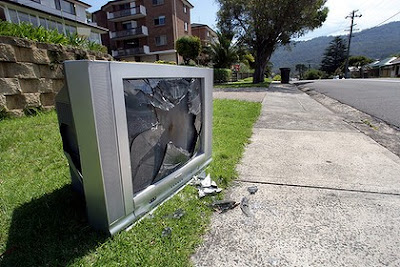25 March 2012
OPINION
Annabel Crabb
The streets are full of dead televisions. They lurk mutely on nature strips, empty-eyed. They gather in reproachful little clusters on vacant blocks. On some, the screens have been stoved in; a further indignity inflicted by the wanton boots of passing hoodlums. The most heartbreaking of all are the ones with the remote controls hopefully balanced on top of them, as tragic as an abandoned dog carrying a leash in its mouth.
The ones with their cords snipped are at least realistic. They're never going to work again, and they know it.
What's going on? It used to be that a television was something you very much wanted to get into your house. And now you can't give them away. It's happening everywhere.
You can see them from the air when you fly in low over any Australian city and look carefully. From that modest elevation, the sense of a national mood is clearer; it looks like the aftermath of an especially drunken Christmas party at Harvey Norman, or perhaps a powerful tribal response to Nine's Excess Baggage.
Televisions are now finding out how newspapers have felt for years. Though at least you can line a budgie cage with an old newspaper. All you can do with old TVs is create witty aquariums or take gritty black-and-white photos of them lying on their sides in the urban environment and there's not much call for either, alas.
Our collective excuse for this waste is the switch-over from analog to digital signals. But the dirty little secret is that our profligate approach to TVs is here to stay.
This year, 2.5 million TVs will - as a spokesman from the federal environment department delicately puts it - ''reach the end of life''. Of these, he says, ''an estimated 500,000 will be recycled, while the remainder will be stored or disposed of to landfill''.
And it's going to get worse; the department estimates that by 2028, the annual figure of tossed-out TVs and computers will reach 44 million.
It's not just the digital switch. We can't blame Stephen Conroy, or the pensioners he keeps scaring the life out of with free set-top boxes that are supposed to fit snugly on to their 1986 Rank Arenas. Chucking TVs is now something we just do. We do it because a digital telly that cost $2250 in 2005 now costs a few hundred bucks. (The high Australian dollar might be ruining manufacturers, food exporters and tourism operators but their retrenched workers will at least be able to recline and enjoy daytime soaps on very competitively priced giant screens).
We do it because we want a bigger one. A decade ago, the median screen size was 86 centimetres but by 2009 that had ballooned to 116 centimetres; the figures read like a Kardashian bust-size chart. By 2015, the manufacturer Sharp predicts that 152 centimetres will be the norm. What this all means is that you can't give old tellies away.
Spare a thought for burglars, who now face urgent professional development challenges. What's the point of nicking a television when the streets are already full of them?
Being burgled can be a confronting experience for a range of reasons, one of which is that one is taught brutal lessons about the real-world value of one's most beloved items.
My father-in-law's leather jacket was once left on his bed, rather pointedly, by a villain who made off with just about everything else. And the burglary stats certainly make deflating reading if you happen to be a television.
A spokesman for the insurance company GIO, Duncan Bone, explains that according to last year's NSW figures, more bangles were reported stolen than LCD televisions. BANGLES.
That's as distinct from bracelets, of which more were stolen than bangles and televisions combined.
''Today's burglar clearly doesn't enjoy heavy lifting,'' is Bone's diagnosis. ''It's all about high-value portable items, with jewellery the No.1 item stolen by a long shot, followed by laptop computers, digital cameras and bicycles.''
One of my work colleagues felt inexplicably sorry for her faithful old telly recently when a post-heist audit revealed that her burglar had ignored the device entirely in favour of her pink patent Prada heels.
''The police were no better, when I pointed it out,'' she recalls. ''They looked at the TV and then with puzzlement at me: 'Who'd want to steal that?' ''
The problem is that throwing away old tellies is dangerous. The boxy cathode ray ones are full of hazardous materials such as mercury, cadmium, brominated flame-retardant plastics and traces of Baywatch.
So the federal government has set up something called the National Television and Computer Recycling Scheme, which will start collecting our junk in the next few months. Soon, the carcasses will be gone from the streets. But televisions will never again be the treasures they once were.
Annabel Crabb writes for the ABC's The Drum, at abc.net.au/thedrum

No comments:
Post a Comment